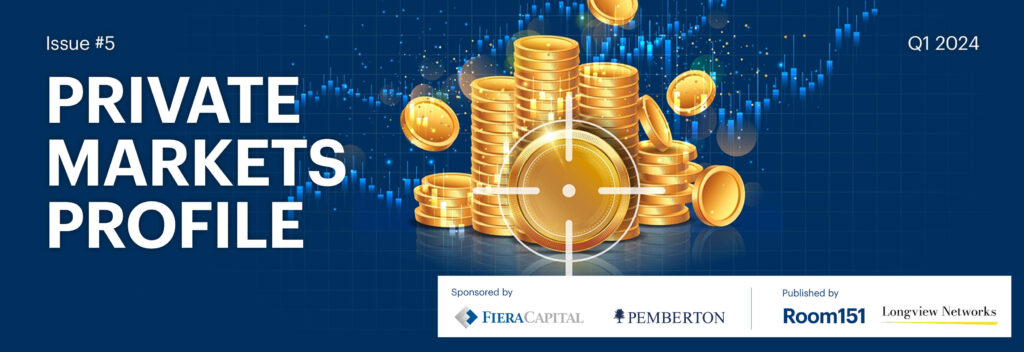The £56bn pool LGPS Central which invests on behalf of eight local government pension funds in the West Midlands has recently placed significant investments in private credit. LGPS Central CIO Gordon Ross sat down with Room151 to discuss the appeal of the asset class.
This interview was first published in the Private Markets Profile and can also be accessed here.

LGPS Central recently increased its allocations to private credit. Why did you opt for private markets as opposed to listed debt?
In a way, we did both. Following our partner funds strategic asset allocation requirements, we created four different private credit partnerships; each of them has a different targeted return. With the enormous amount of money going into private equity, the closure of the IPO markets, a lot of private equity funds were looking to borrow. Since the financial crisis, mainstream banks have been pulling their loan books down so the opportunities are there.
Historically, a lot of money has been chasing private markets and a lot of the protections we would be looking for as an investor have been diluted and covenant protections have been frozen. That has now been reversed to a degree because of the dynamic between private equity and private credit; the investor is almost in charge again and can be picky enough to choose from the private credit market with greater protection.
This is very different from two or three years ago, when so much money was chasing GPs that it would dilute protection – it is now the other way around. The GPs need us investors. It is an opportunity to time the market, and we now have better protection.
Obviously, with higher rates comes the problem of refinancing. Does that mean there are going to be more defaults going forward? That is something we are very cognisant of but the indications are that there is not going to be a dramatic uptake in defaults. Again, we can choose who we are lending to and tend to choose the top of the capital structure rather than doing anything too risky.
We tend to be very sensitive to interest cover, the ability of borrowers to cover what they are paying back to us. How much coverage do they have to pay interest? Somebody once described that as the forgotten covenant because people didn’t use to worry about it. This is not formally written down but it’s a useful metric to measure the sensitivity of a borrower to higher rates. It is one of the metrics we use when we allocate to the private debt market.
When you say ‘interest cover’, does that mean you are looking at refinancing cycles of outstanding debt?
Yes, depending on which sector you choose, debt can mature in 3-5 years. These can be quite short cycles or much longer. The other question is which sectors you want to go into. We tend to avoid secondary markets because the information and liquidity may not be as we require it.
I use the word liquidity in private markets with the caveat that it is obviously not as liquid as quoted markets. But there are degrees of liquidity depending on which sectors you invest in.
Are you doing this research in-house or would this be covered by the managers you work with?
Something like the refinancing cycles is just modelling – you know what the maturities are and you can then match this to forward rates in public markets to establish if it’s realistic or sensible. Are they refinancing at a period where the curve is going to be steep, or rates still high?
So you are doing that in-house?
Yes. But the GP will obviously also give their opinion, they will also have all the data at the ready and give us access to data rooms. If they haven’t done this, we would be concerned. That is the biggest risk we have – defaults. Credit downgrades are less of an issue – we just want to make sure we at least get our money back! They have their own metrics but we have to make sure they’re sensible.
Do you have a geographic focus in terms of where you are lending?
Diversification notwithstanding, we tend to be fairly agnostic in terms of where we are lending. Having said that, we are going into these loans knowing where the GPs tend to have a strong track record; the sectors will be a by-product of that. As time goes by, there will be more focus on private lending where you have more control over covenants and who you are lending to.
A few years ago, people were saying it’s a borrowers’ market, is it fair to say it’s now a lenders’ market?
Yes, although there is still a lot of money out there, but rates are making people more cautious. Therefore, you are no longer having to sacrifice protection because you want an extra five basis points. We now can be choosier.
Final question: Do you think we have reached a peak in rate hikes and does that mean it’s a good idea to lock in today’s rates?
The market would have you believe that we have reached a peak of rates. The market now looks to find out when the next change of direction is happening. Are rates coming down in Q1 or Q4 2024? Who is going to be the first? It looks like it’s going to be Europe.
But I believe this 2% inflation target is something that is going to be a lot stickier to achieve. Core inflation is going to be very stubborn. It is now a question of will the fear of recession be sufficient for central banks to cut bank rates before they have got to their 2% target? In which case, will that damage their credibility?
Another factor to be aware of is the American elections. The Fed, aware of the election in November and not wanting to become politicised, may either have to act or not act in anticipation of the election. This means they could potentially cut rates before they have reached their declared 2% target or required criteria. What will that do for their credibility?
I have been in these markets for over 43 years and every time the market gets something into its head something happens to make all those people wrong. The current market is discounting substantially more US rate cuts than the FED are implying by their ‘dot-plots’ and recent data implies a soft landing there. I have a horrible feeling that this could be one of those instances. Everyone is looking for rate cuts sometime this year and you can see market yields down 50 or 60 basis points. People were talking about 5%; they are now talking about 4% for 10 year US rates.
The danger is that everyone gets carried away and then we get some problem that causes inflation to spike again (wage increases, supply chain problems causing higher prices). The market then has to react, which will have an effect on the shapes of yield curves and the potential speed of rate reductions.
Gordon Ross will also act as the chair for Room151’s LGPS North. More information about the event can be found below
—————
FREE bi-weekly newsletters
Subscribe to Room151 Newsletters
Follow us on LinkedIn
Follow us here
Monthly Online Treasury Briefing
Sign up here with a .gov.uk email address
Room151 Webinars
Visit the Room151 channel














